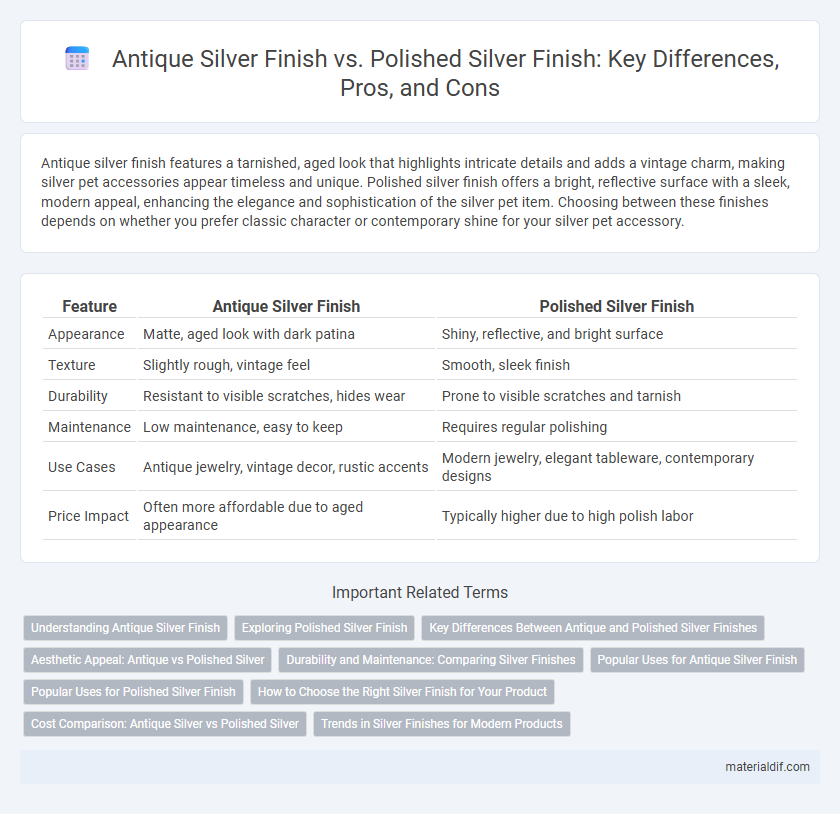Antique silver finish features a tarnished, aged look that highlights intricate details and adds a vintage charm, making silver pet accessories appear timeless and unique. Polished silver finish offers a bright, reflective surface with a sleek, modern appeal, enhancing the elegance and sophistication of the silver pet item. Choosing between these finishes depends on whether you prefer classic character or contemporary shine for your silver pet accessory.
Table of Comparison
| Feature | Antique Silver Finish | Polished Silver Finish |
|---|---|---|
| Appearance | Matte, aged look with dark patina | Shiny, reflective, and bright surface |
| Texture | Slightly rough, vintage feel | Smooth, sleek finish |
| Durability | Resistant to visible scratches, hides wear | Prone to visible scratches and tarnish |
| Maintenance | Low maintenance, easy to keep | Requires regular polishing |
| Use Cases | Antique jewelry, vintage decor, rustic accents | Modern jewelry, elegant tableware, contemporary designs |
| Price Impact | Often more affordable due to aged appearance | Typically higher due to high polish labor |
Understanding Antique Silver Finish
Antique silver finish involves a deliberate oxidation process that creates a darkened, aged appearance on the silver surface, highlighting intricate details and textures that polished silver finish cannot achieve. This finish is favored for its vintage charm and ability to mask tarnish, making it popular in jewelry, tableware, and decorative items. Unlike polished silver, which is smooth and reflective, antique silver emphasizes depth and character, enhancing the visual appeal of silver pieces with historical or rustic aesthetics.
Exploring Polished Silver Finish
Polished silver finish features a reflective, mirror-like surface that enhances brightness and highlights intricate design details, making it popular for modern and elegant silverware. Unlike antique silver finish, which emphasizes a matte, aged appearance with darkened crevices, polished silver offers a sleek, smooth texture that resists tarnishing when properly maintained. This finish is favored in jewelry and decorative items where a contemporary and pristine aesthetic is desired.
Key Differences Between Antique and Polished Silver Finishes
Antique silver finish features a darkened, oxidized look that enhances intricate details and creates a vintage, aged appearance, while polished silver finish offers a bright, reflective surface with a smooth and shiny texture. The antique finish uses chemical treatment or hand-applied patinas to create depth and character, whereas polished silver undergoes buffing and polishing to achieve its glossy effect. Durability varies as polished silver resists tarnish better but requires frequent cleaning, whereas antique silver is less prone to showing wear and scratches due to its textured surface.
Aesthetic Appeal: Antique vs Polished Silver
Antique silver finish offers a vintage, oxidized look with darker tones and intricate patina that highlights details and adds a sense of history, making it ideal for rustic or traditional aesthetics. Polished silver finish provides a bright, reflective surface with a sleek, modern shine that enhances elegance and sophistication, perfect for contemporary or formal settings. Both finishes enhance silver's beauty but cater to different stylistic preferences and interior design themes.
Durability and Maintenance: Comparing Silver Finishes
Antique silver finish offers enhanced durability due to its protective patina, which helps resist tarnishing and scratches better than polished silver finish. Polished silver finish, while visually striking with its high gloss, requires frequent maintenance and careful cleaning to prevent tarnish and maintain shine. Choosing an antique silver finish reduces upkeep demands and extends the lifespan of silver items in daily use.
Popular Uses for Antique Silver Finish
Antique silver finish is widely favored for vintage-style jewelry, decorative home accents, and ornate picture frames due to its rich patina that highlights intricate details. This finish enhances the appearance of heirloom pieces and costume jewelry by providing a timeless, weathered look that contrasts with polished silver's shiny and reflective surface. Its versatility makes it ideal for items intended to evoke historical charm and rustic elegance.
Popular Uses for Polished Silver Finish
Polished silver finish is highly popular in jewelry making due to its bright, reflective surface that enhances the appearance of rings, necklaces, and bracelets. This finish is also common in luxury tableware and decorative items, providing a sleek, elegant look that highlights intricate designs. Furthermore, polished silver is favored for trophies and awards where a shiny, prestigious appearance is essential.
How to Choose the Right Silver Finish for Your Product
Choosing the right silver finish for your product depends on the desired aesthetic and durability requirements. Antique silver finishes offer a vintage, tarnished look that enhances intricate details and requires less frequent polishing, making them ideal for items seeking a classic, aged appeal. Polished silver finishes provide a bright, reflective surface that highlights a sleek, modern style but may require regular maintenance to prevent tarnish and preserve shine.
Cost Comparison: Antique Silver vs Polished Silver
Antique silver finish typically costs less than polished silver finish due to its less labor-intensive production process and the use of patina or oxidation to create the aged look. Polished silver finish involves extensive buffing and plating to achieve a reflective, high-shine surface, which increases manufacturing expenses. Choosing antique silver offers cost savings while maintaining a classic aesthetic compared to the premium pricing associated with polished silver items.
Trends in Silver Finishes for Modern Products
Antique silver finish offers a vintage, patinated look favored in contemporary jewelry and home decor for its timeless, rustic appeal, while polished silver finish delivers a sleek, reflective surface popular in modern minimalist designs. Current trends show a rising demand for mixed finishes that combine the textured depth of antique silver with the smooth brilliance of polished silver, enhancing versatility and aesthetic contrast. Manufacturers increasingly incorporate sustainable techniques in silver finishing, responding to consumer preferences for eco-friendly and durable products.
Antique Silver Finish vs Polished Silver Finish Infographic

 materialdif.com
materialdif.com